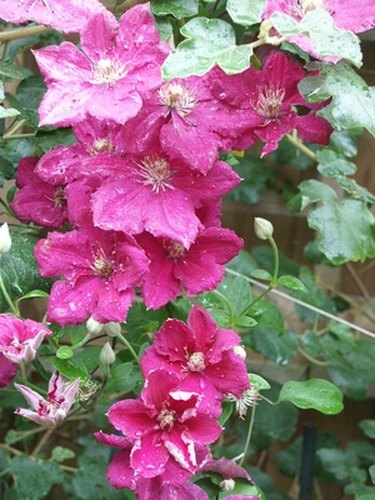
Clematis is a flowering vine that grows vigorously. Flower shape, color and growth rate of the vine vary by species. Clematis is ornamental but is often used for practical purposes; when encouraged to creep up a trellis, the plant can shade your home during the summer. Brown leaves on a clematis plant can indicate several different problems, all of which can be resolved with a little detective work and proper care.
Heat
Video of the Day
The hot sun may cause clematis leaves to turn brown, usually in the height of the summer heat. Rest assured that your clematis is not necessarily dying, but is suffering from a case of sunburn, so to speak. If possible, move the vine to a new location that gets less direct sun. Make the transfer before new growth appears, to avoid disturbing the natural blooming season. Continue to water the clematis as needed to combat the heat. Clematis requires at least an inch of water weekly from irrigation or natural precipitation.
Video of the Day
Spider Mites
A spider mite infestation can cause browning on the leaves of the clematis. The discoloration is usually a gradual process, with the leaves turning pale tan, then a deeper brown color before dropping off the plant. Spider mites are tiny pests that suck the sap of the leaves, causing them to die. Spider mites lay eggs on the leaves of the clematis; new mites hatch during the next growing season. A forceful stream of water may be enough to dislodge the mites. Pesticides may be required for moderate to severe infestations.
Wilt
Clematis wilt is a fungal disease that can affect the entire plant. The stem rots, leading to a physical collapse of the vine. Following collapse, the stem and leaves turn brown or black in color and die. Clematis wilt appears suddenly, literally overnight in some cases. The plant will look healthy one day and sick the next. Remove the affected areas of the clematis and wait until the next year to determine if the plant will come back. If healthy buds exist under the ground, it's likely that the clematis will grow anew in the spring.
Prevention
Spraying the clematis with fungicides and pesticides may prevent browning of the leaves due to insect pests and fungal disease. Preventive chemical control is not always foolproof; newly planted vines are more susceptible to clematis wilt than established plants. Large-flowering clematis also carry a higher risk of clematis wilt.
- NDSU Extension Service; Questions on Clematis; Ron Smith
- International Clematis Society; Growing Queries; Bill Bird; February 28, 2011
- Clemson University Cooperative Extension;Clematis; Karen Russ and Bob Polomski; September 1999
- International Clematis Society; Clematis Wilt; Bill Bird; February 28, 2011